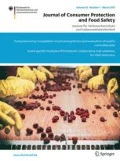Zusammenfassung
Die Stabilisotopenanalyse ist ein effizientes Verfahren in der Authentizitätsprüfung von Lebensmitteln. Mit ihr kann ein Etikettenschwindel bezüglich verwendeter Rohstoffe, verwendeter erlaubter und unerlaubter Zusätze erkannt und damit Verfälschungen nachgewiesen werden. Eine Bestimmung der geografischen Herkunft mittels Stabilisotopenanalyse ist möglich, wenn sich die Isotopenverhältnisse der geografischen Herkünfte deutlich voneinander unterscheiden und wenn eine ausreichende Anzahl von Vergleichsdaten authentischer Erzeugnisse oder verlässlicher Handelsproben vorliegt. Aufgrund der zunehmenden Qualität von Verfälschungen ist eine ständige Weiterentwicklung der Isotopenmethoden erforderlich.


Literatur
Bateman AS, Kelly SD, Jickels TD (2005) Nitrogen isotope relationship between crops and fertilizer: Implications for using nitrogen isotope analysis as an indicator of agricultural regime. J Agric Food Chem 53:5760–5765
Bateman AS, Kelly SD, Woolfe M (2007) Nitrogen isotope compositon of organically and conventionally grown crops. J Agric Food Chem 55:2664–2670
Brause AR, Ratermann JM, Petrus DR (1984) Verification of authenticity of orange juice. J Assoc Off Anal Chem 67:535–539
Calderone G, Guillou C (2008) Analysis of isotopic ratios for the detection of illegal watering of beverages. Food Chemistry 106:1399–1405
LChG (2010) Herkunft und Authentizität von Vanillearomen, Grundlagenpapier der Arbeitsgruppen „Aromastoffe“ und „Stabilisotopenanalytik“ der Lebensmittelchemischen Gesellschaft. Lebensmittelchemie 64: 43-48
Schmidt HL, Roßmann A, Werner RA (1998) Stable Isotope Ratio Analysis in Quality Control of Flavourings. In: Ziegler E, Ziegler H (eds) Flavourings, 1st edn. Wiley-VCH, Weinheim, pp 539–594
White JW, Winters K (1989) Honey protein as internal standard for stable carbon isotope ratio detection of adulteration of honey. J Assoc Off Anal Chem 72:907–911
Author information
Authors and Affiliations
Corresponding author
Additional information
Der Kongress „Sichere Lebensmittel – Von der Früherkennung bis zur Sanktion“ fand vom 18. bis 19. Oktober 2016 in Erlangen statt und wurde vom Bayerischen Landesamt für Gesundheit und Lebensmittelsicherheit (LGL) organisiert und durchgeführt.
The congress “Sichere Lebensmittel – Von der Früherkennung bis zur Sanktion” took place from 18. to 19. October 2016 in Erlangen, Germany and was hosted and organized by the Bavarian Health and Food Safety Authority (LGL).
Rights and permissions
About this article
Cite this article
Schellenberg, A. Lebensmittelauthentizität: Isotope geben Auskunft. J Consum Prot Food Saf 12 (Suppl 1), 41–43 (2017). https://doi.org/10.1007/s00003-016-1080-y
Published:
Issue Date:
DOI: https://doi.org/10.1007/s00003-016-1080-y

